Everyone is pretty certain that winter has finally blown away — which marks the beginning of gardening season!
Anyone, and I mean anyone, can learn about gardening and can create their own garden. The gardening learning process is satisfying, and once even one of your plants begins to grow from seedling to sprout, you’ll discover a tasty satisfaction you’ll never tire of feeling.
Where do you start?
Thankfully, anyone with an internet connection can find multiple articles about gardening and plenty gardening “how-to” and “best practices” guides.
A few of my favorite sites that have an endless supply of gardening articles, guides and tips are Mother Earth News and The Old Farmer’s Almanac.
If you aren’t in the mood to search however (and who can blame you—you’re already online all day), the following is a smattering of need-to-know gardening information.
Container or plot?
You do not need average, or even your own backyard, to cultivate your inner farmer. Anyone can garden — even in small spaces, super urban spaces and spaces with intense weather. Although you may not be able to grow a large number of vegetables, you can fit a variety of produce types in containers.
But before you set out to fill your containers or start to tear up your backyard, consider the following…
Are you planting in a good location?
A good garden location is sunny and in a stable environment.
According the The Old Farmer’s Almanac, most vegetables need at least six hours of full sunlight a day. But if you only have access to space that’s shady, don’t give up! Just look for vegetable varieties that thrive in partial sun.
A good stable environment also is important. Basically, avoid placing containers or a garden plot in an area that could easily flood or be affected by strong winds.
Size does matter
Yes, I just made a shameless penis-size joke, but the sentiment does apply. Every new gardener should start small. I know this truth intimately.
I was overly ambitious when I began gardening. I just assumed everything would work out (never assume) and was very disappointed. Basically, I did too much and my yard didn’t get enough sun. Consequently, I spent a lot of money to basically sweat… a lot. Although I don’t regret the experience, I do wish I would have started smaller.
If you plan on digging a plot, The Old Farmer’s Almanac suggests uprooting an area that’s about 16×10 feet. “Make your garden 11 rows wide, with each row 10 feet long,” the Almanac states. “The rows should run north and south to take full advantage of the sun.”
If you plan on using containers, purchase vegetable-friendly containers that are roomy. Also, make certain you have plenty of potting soil.
It’s best to place one plant per container if the vegetable is something that produces multiple vegetables, such as tomatoes, peppers, etc. If you want to grow leafy greens, radishes, and carrots, you can easily plant multiple seeds per container. Thankfully, most seeds come with great easy-to-follow instructions on their seed packets.
Pick the right vegetables
The Almanac explains that the following vegetables could yield more than one crop per season: beans, beets, carrots, cabbage, kohlrabi, lettuce, radishes, rutabagas, spinach and turnips.
Other popular vegetables people have success growing include:
Tomatoes — 5 plants, staked
Zucchini squash — 4 plants
Peppers — 6 plants
Marigolds to discourage pests. These flowers are also bright and beautiful.
And…
Don’t forget to buy good-quality seeds (I’m a fan of Eden Brothers seeds), water your plants and seeds regularly and harvest at the right time.
Most importantly though, have fun in the fresh air. You never know what you might grow!
—
Abbie Stutzer is a writer and editor from Lawrence, Kansas. Find her on Twitter at @abbiestutzer and on Insta at @abbiestutzer. Email her at abbie@ynotcam.com.
Image via Chris Johnson.










